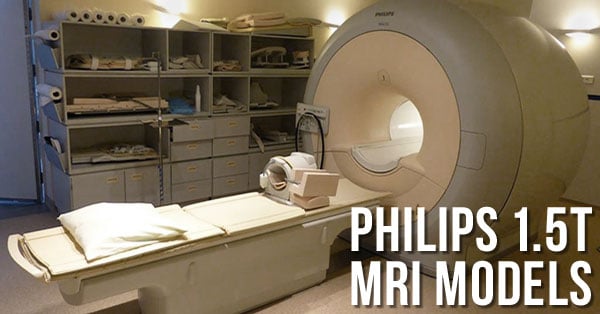
If you're in the market for an MRI machine, chances are you'll see three big manufacturer names out front- Philips is definitely one of them (along with GE and Siemens).
Philips 1.5T MRI machines come in 4 main varieties that each shine in different areas. We've compiled a review of each 1.5T Philips scanner below to highlight some of those differences and strengths and help you along the way to choosing the best MRI for your facility's needs.
Philips Ingenia Ambition 1.5T
The Ingenia Ambition is the very latest 1.5T offering from Philips. If you'll pardon the pun, the most 'ambitious' new tech the Ambition brings to the table is helium-free operation. Built around the new BlueSeal magnet, the Ambition is cooled by new technology that uses just 7-8 liters of liquid helium in a zero-loss, closed loop. That's right: JUST 7-8 LITERS! Compare that to the 1500 or so most of us are used to!
While the prospect of being able to, as Philips says, "forget about helium" is certainly intriguing, those purchasing on the secondary market probably won;t find an Ambition coming down the pike for the better part of a decade. On that same note, when they do show up, you can bet on a relatively steep cost.
Philips Ingenia 1.5T
Philips is known for powerful gradients, and this model is no exception. Equipped with the Omega HP gradient package, this 70cm wide-bore MRI operates at 45 mT/m and 200 mT/m/ms, delivering outstanding image quality. There are also a number of technology breakthroughs with this system, such as:
-
EasyExpand and dStream: dStream allows for analog-to-digital conversion (ADC) from within each coil, transmitting information via fiber optic cable. EasyExpand is the resulting technology from dStream, enabling the system to be channel-independent and “expand” to however many channels are available to a particular coil. If you decide to upgrade from an 8-channel coil to a 16-channel coil, the system will then operate at 16 channels.
- FlexCoverage and FlexConnect: FlexCoverage is a technology found in the anterior coil that can flex to conform to each patient. In addition, there is a built-in posterior coil inside of the table. FlexConnect allows for easy, one-handed cable connections and an auto-eject feature for easy table undocking.
The Ingenia is now nine years old, but users are holding onto them, making them rare on the secondary market.When they can be found, they are pricey commodities. However, if you’re reading this blog and have a while before you'll pursue an upgrade in earnest, keep an eye out for them. The high-tech features and expandability make Ingenias a great choice if one aligns with your budget.
How to Find Late-Model or Rare MRI Scanners
Philips Achieva 1.5T
The Achieva model can be found fairly easily on the secondary market and represents a great value. Although the magnet is not as efficient as other models (requires a helium refill every 3 years), it does keep to Philips’ tradition of offering powerful gradients. Additionally, the Achieva is available as two builds, distinguished by “A-Series” or “SE”. The A-Series is by far the most common version, but the SE offers a compact and economical MRI that can reduce energy usage by up to 50% via PowerSave.
The Achieva is upgradable to a 32-channel system, but this upgrade is rarely seen. 8-channel is the most common setup. With automated processes such as ExamCards and SmartExam, the Achieva represents great value on the secondary market and still offers workflow optimization software.
1.5T MRI Machine Price Cost Guide
Philips Intera
If you’re looking to minimize your upfront costs as much as possible while still benefiting from a 1.5T magnet, then the Intera might be of interest. Systems and replacement parts are easy to find because they have been around since about 2000. Plenty of parts and a lot of independent service options mean that maintenance costs are going to be minimized, and that is always a good thing!
This system comes standard as a 4-channel MRI and features SmartExam and ExamCards. The Intera may not sport all of the high-tech features of its successors, but for facilities with more restrictive budgets, it can strike an ideal balance between investment value, high-field performance, and a wide range of clinical applications. If that sounds like the balance you're looking for, let us know!
The Takeaway
The information above is certainly not the exhaustive catalog of Philips technical spec, but the goal here is to get you a frame of reference to work from as you approach the secondary MRI market. If you have questions about these Philips 1.5T models, we're happy to help! If you'd like to know about GE 1.5T MRI or Siemens 1.5T MRI, be sure to read our other blogs in this series.

Steve Rentz
Steve Rentz is the Product Manager for MRI Scanners at Block Imaging. Steve's goal is to earn each customer's trust and business by specifically addressing the needs of their unique project. When Steve is not helping customers with their MRI needs, he enjoys running, swimming, and woodworking.





